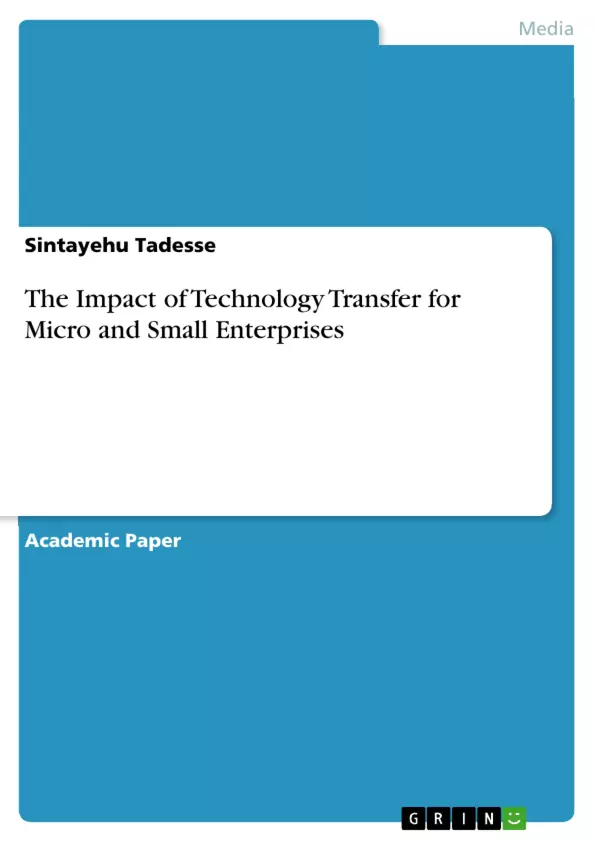The goal of this action research was to see how technology transfer from Misrak Polytechnic College affected small-scale businesses. Based on this, the researcher concentrated on transferred technology in the academic years 2012 and 2013 E.C. and employed a survey methodology to achieve the study's goal. A total of 57 trainers and 8 technology team members were chosen for this research to transfer and facilitate technology. From them 81.5% were male and 18.5% female. In addition, 57 firms were chosen to acquire technology from trainers. Data was collected through questionnaires and observation. To emphasize the link and variance of the variables, the data collected through the questionnaire was analyzed using frequency %, mean and standard deviation. To complement the quantitative statistics, the information gathered through open ended questionnaires was evaluated qualitatively.
The findings suggest that trainers' problem-solving methods on technology transfer are based on their knowledge of how to deal with technology. Although the trainers have a basic understanding of technology, the results show that additional understanding is required. Aside from that, the findings examine knowledge and skills in value chain analysis. The mean value was 3.38 and the standard deviation was computed as 1.07, which is larger than one, implying that the data was spread out over a wide range of values, implying that respondents had a variety of alternatives when it came to this particular variable.
There are no widespread surveys on the college's suitability for technology development and transfer. In the previous two years, 85.2 percent of trainers produced and transmitted technology for small businesses, but no single technology has been duplicated or made available to the general public by SMEs. The transferred technology is not being imitated by SMEs, but the results demonstrate that the enterprises are interested in technology transfer. The majority of the trainers believe that the transferred technology has a functional difficulty, lacks a nice physical look, and does not match the planned goal.
Inhaltsverzeichnis (Table of Contents)
- CHAPTER ONE
- INTRODUCTION
- 1.1 Background of the Study
- 1.2 Statement of the Problem
- 1.3 Basic Research Question
- 1.4 Objectives of the study
- 1.4.1 General Objective
- 1.4.2 Specific objective
- 1.5 Significance of the Study
- 1.6 Scope of the Study
- 1.7 Limitation of the Study
- 1.8 Organization of the Study
- CHAPTER TWO
- Related Literature Review
- 2.1 The Definition of Technology
- 2.2 The Concept of Technology Transfer
- 2.3 Channels of Technology Transfer
- 2.3.1 Market-mediated channels
- 2.3.2 Non-market channels
- 2.4 Process of Technology Transfer
- 2.5 The Role of Stakeholder in Technology Transfer
- 2.6 Linkages of TVETS and MSES
- 2.7 The Role of TVET to Strengthening MSE
- 2.8 Technology and Micro small and medium enterprises (SMEs)
- 2.9 Factor Affecting Technology Transfer in MSE
- 2.10 Conceptual Framework
- CHAPTER THREE
- Research Design and Methodology
- 3.1 Research Design
- 3.2 Intervention Strategies
- 3.2.1 Initial Reflection (Problem Identification)
- 3.2.2 Plan
- 3.2.3 Action Plan
- 3.3 Population Size
- 3.4 Samples and Sampling Techniques
- 3.5 Sources of Data
- 3.6 Types of Data and Tools of Data Collection
- 3.7 Procedures of Data Collection
- 3.8 Data Analysis
- 3.9 Ethical Considerations
- CHAPTER FOUR
- 4.1 Background Characteristics of the Respondent
- 4.2 Analysis of Main Data
- Chapter Five
- 5.1 Summary
- 5.2 Major Finding
- 5.3 Conclusions
- 5.4 Recommendation
- REFERENCE
Zielsetzung und Themenschwerpunkte (Objectives and Key Themes)
This research aims to investigate the impact of technology transfer on small-scale enterprises. The study seeks to understand how technology transfer influences the operations, growth, and competitiveness of these enterprises. It also aims to identify key factors facilitating and hindering successful technology transfer in this context.
- Impact of Technology Transfer on Small-Scale Enterprises
- Factors Influencing Technology Transfer in Small-Scale Enterprises
- Role of TVETs in Strengthening Small-Scale Enterprises
- Linkages between TVETs and Small-Scale Enterprises
- The Role of Stakeholders in Technology Transfer
Zusammenfassung der Kapitel (Chapter Summaries)
Chapter One provides an introduction to the research, outlining the background, problem statement, research question, objectives, significance, scope, limitations, and organization of the study. Chapter Two delves into a comprehensive literature review, examining the definition of technology, the concept of technology transfer, its channels and process, the role of stakeholders, the linkages between TVETs and small-scale enterprises, and the impact of technology on these enterprises. Chapter Three details the research design and methodology employed in the study, including intervention strategies, population size, sampling techniques, data sources, data collection methods, data analysis procedures, and ethical considerations. Chapter Four presents the findings of the research, focusing on the analysis of collected data and its implications for understanding the impact of technology transfer on small-scale enterprises. Chapter Five concludes the research by summarizing key findings, drawing conclusions, and providing recommendations for future research and policy implications. This chapter does not provide detailed insights to avoid revealing major findings or spoilers.
Schlüsselwörter (Keywords)
This research focuses on the transfer of technology, its impact on small-scale enterprises, and the role of TVET institutions in facilitating this process. Key terms include technology transfer, small-scale enterprises, TVET, stakeholders, innovation, competitiveness, and sustainable development.
- Arbeit zitieren
- Sintayehu Tadesse (Autor:in), 2022, The Impact of Technology Transfer for Micro and Small Enterprises, München, GRIN Verlag, https://www.hausarbeiten.de/document/1314871


